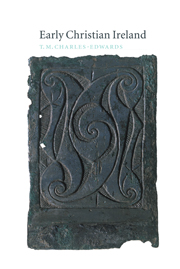Book contents
- Frontmatter
- Contents
- List of maps
- List of tables
- List of figures
- Acknowledgements
- Abbreviations
- A note on pronunciation
- A note on the Chronicle of Ireland
- Introduction
- 1 Ireland in the seventh century: a tour
- 2 Irish society c. 700: I. Communities
- 3 Irish society c. 700: II Social distinctions and moral values
- 4 Ireland and Rome
- 5 Conversion to Christianity
- 6 The organisation of the early Irish Church
- 7 Columba, Iona and Lindisfarne
- 8 Columbanus and his disciples
- 9 The Paschal controversy
- 10 The primatial claims of Armagh, Kildare and Canterbury
- 11 The origins and rise of the Uí Néill
- 12 The kingship of Tara
- 13 The powers of kings
- 14 Conclusion
- Appendix: genealogies and king-lists
- Glossary: Irish and Latin
- Bibliography
- Index
8 - Columbanus and his disciples
Published online by Cambridge University Press: 11 September 2009
- Frontmatter
- Contents
- List of maps
- List of tables
- List of figures
- Acknowledgements
- Abbreviations
- A note on pronunciation
- A note on the Chronicle of Ireland
- Introduction
- 1 Ireland in the seventh century: a tour
- 2 Irish society c. 700: I. Communities
- 3 Irish society c. 700: II Social distinctions and moral values
- 4 Ireland and Rome
- 5 Conversion to Christianity
- 6 The organisation of the early Irish Church
- 7 Columba, Iona and Lindisfarne
- 8 Columbanus and his disciples
- 9 The Paschal controversy
- 10 The primatial claims of Armagh, Kildare and Canterbury
- 11 The origins and rise of the Uí Néill
- 12 The kingship of Tara
- 13 The powers of kings
- 14 Conclusion
- Appendix: genealogies and king-lists
- Glossary: Irish and Latin
- Bibliography
- Index
Summary
In or, Columban us, then a monk at the monastery of Bangoron the south side of Belfast Lough, received the permission of his abbot, Comgall, to leave Ireland as a peregrinus, one who has to live as an exile. He was already an alien of a kind, in that he was a Leinsterman by birthand had left his native province, first to further his education by seeking out a renowned teacher named Sinell, and secondly by entering the monastery of Bangor in the province of Ulster. Now he sought Comgall's support for his intention to find a place of more intense exile. His journey took him via Brittany to Burgundy, the Merovingiankingdom probably still ruled by Guntram. By this journey, Columban usprecipitated a fundamental change in Frankish Christianity. He is bestunderstood, however, as instigating change rather than causing it singlehandedly; he achieved so much because he and his disciples secured thesupport of Frankish kings and aristocrats. In addition, moreover, to hisinuence in Francia, his achievements, and the controversies theyaroused, were to have important consequences both for the country of his birth and for Anglo-Saxon England.
Columbanus is a major figure for two reasons. First, he is the greatest of the peregrini who left Ireland for continental Europe. In Britain there were other major figures, in particular Columba of Iona and Aidan, the bishop of the Northumbrians; but amongst those Irishmen who went to the continent, such as Fursa, none had so great an influence as Columbanus.
- Type
- Chapter
- Information
- Early Christian Ireland , pp. 344 - 390Publisher: Cambridge University PressPrint publication year: 2000



